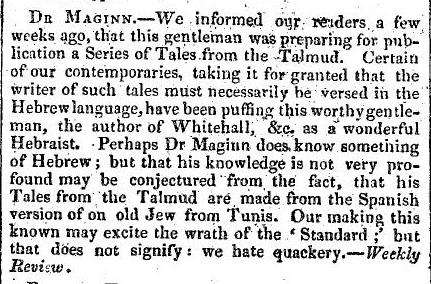
Friday, January 29, 2010
Wednesday, January 27, 2010
Dayanim in brown suits and Kabbalah
Another "distinguished" speaker lamented that he saw a "supposed" dayan actually wearing some "brown" article of clothing and "smelled of cologne"; the EJF speaker commented something along the lines of, "can you imagine such a person serving as a dayan?"… (link)It has been widely believed that the '"supposed" dayan' who fails to conform to the contemporary Chareidi dress code is none other than Rabbi Barry Freundel, who is in fact a dayan, and is also the head of the RCA's conversion committee.
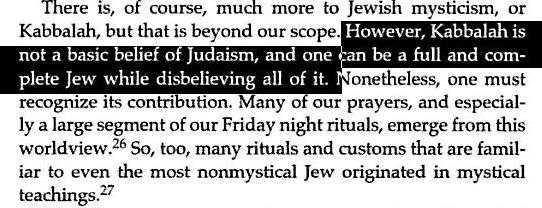
Judaism has several axioms, called ikkarei emunah. Rejecting these axioms puts one into the category of heretic. Yet there are few of them. There are many other beliefs in Judaism, and someone who rejects any of those might be grievously wrong, and an idiot, but not necessarily a heretic. This despite how these beliefs have always had, or have gained over time, common acceptance, including among great rabbis.. . .[. . .] in a theological debate, there is great temptation to turn one's frum position into an ikkar, an axiom. That way, you are automatically right; no one can question the foundations of the axiom, and you are not forced to grapple with its foundations yourself. Furthermore, your disputant need not be engaged. He is a heretic for daring to say this, and one should not engage with a heretic! And proof that he is an oisvorf whose words and proofs should not be considered is this position he is putting forth.Thus, as an example, the belief in the integrity of the transmission of the Oral Torah is expanded to include the integrity of the Zohar, despite it being revealed / having been invented in the 13th century. If someone argues that this is not part of Oral Torah, and has proofs of late authorship, this should not be considered. After all, he is a heretic, according to Rambam! This even though Rambam did not agree with certain kabbalistic beliefs and considered them nonsense.
A Gaon's seal.

This seal belonged to the Gaon Nechemia of Pumbedisa.
Tuesday, January 26, 2010
A blessing for Ibn Ezra.
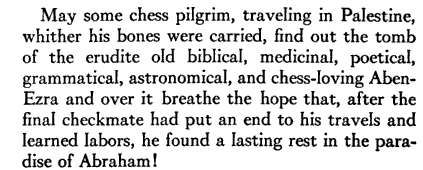
Willard Fiske, The Chess Monthly 3, August 1859 (although the clip above was from a book printed in 1912, chosen for its superior typographical beauty).
Minhag jokes and their historical kernels.
I wonder if anyone's discussed the issue of anecdotes about customs which actually hint, by their details, to significant issues, but the significance is since forgotten, at least in the vulgar versions? I can think of two examples:
1. The tale of the rebbe who cut his fingernails after the mikva. His Chassidim thought it was imbued with significance and wanted to imitate him, until he pointed out to him that his nails are softer and easier to cut after the mikva. In the retellings of this story, the issue of fingernails as a resting spot for ruach ra is not noted. Whether or not such a story is true, surely the issue of whether to cut the nails before or after the purifying agent of the mikva is of some concern to mikva going rebbes.
2. Someone told me the following joke he heard from a leading rosh yeshiva of an earlier generation (its context was the issue of ecumenism in the early '60s): A priest, a minister and a rabbi decide that in the spirit of tolerance and the times, each ought to modify tenets of their religion to bring all men closer together. So the priest says "Well, we'd be willing to do away with Immaculate Conception." The minister says "We'd be willing to do away with the Trinity." The rabbi says "We'd be willing to get rid of the second yequm purkan." This joke almost turns its grain of historical basis on its head. If I understand the joke correctly, the rosh yeshiva meant to say that for Judaism even the least practice is as significant as the chief dogmas of the other religions; ecumenism is pointless. The issue of removing the second yequm purkan (or the whole thing) was a topic in 19th century Reform, and especially in Orthodox polemics about Reform.
Monday, January 25, 2010
Selling Torahs and stories
Touting his expertise in dating parchment, Youlus says he has studied with curators "in Europe," but pressed to say with whom he has studied, he won't give names.Personally I think paleographical expertise might be a little more useful, but maybe I'm wrong about that. CoughShapiraCough.
In a 3-hour interview, Youlus is unable to provide a single name, date, place, photograph or document to back up the Auschwitz stories or any of the others. He says that until Save a Torah was founded in 2004, he kept no records. He refers all requests for documentation since then to the foundation's president, investment banker Rick Zitelman of Rockville.The irony is that pious Jews do not usually call myth 'midrash.'
---
As for Youlus's Torah rescue stories, Berenbaum came to his own conclusion. "A psychiatrist might say they are delusional. A historian might say they are counter-factual. A pious Jew might call them midrash -- the stories we tell to underscore the deepest truths we live," he says. Midrash, in this context, refers to the ancient tradition of rabbis telling anecdotes and fables to convey a moral lesson. "Myth underscores the deepest truth we live," Berenbaum says.
The Talmud-Memorizer-Performer, Rabbi Hirsch Denmark.
This was the clipping:
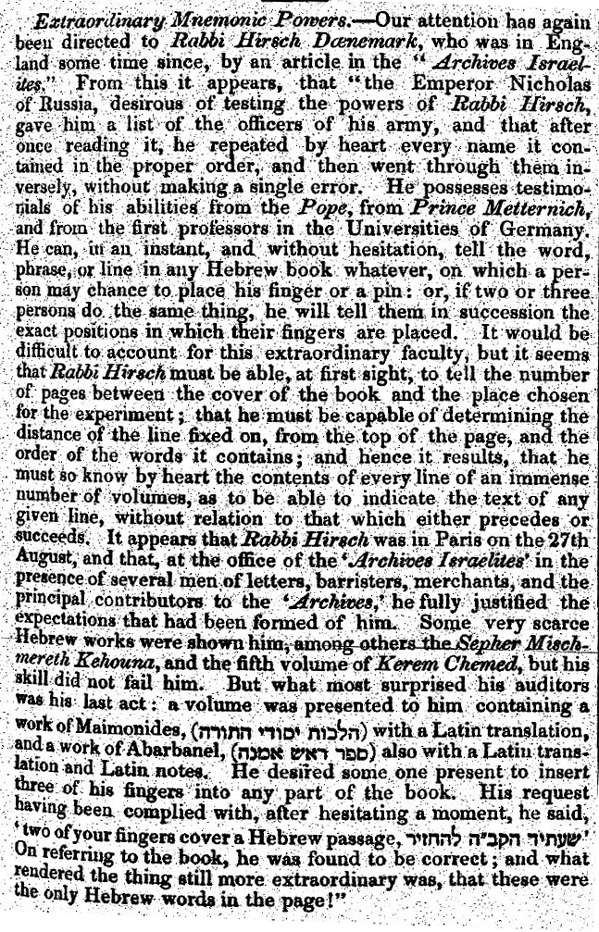
I came across another clipping in the same periodical and realized that this Hirsch Daenmark was still at if a few years later (August 7, 1846):
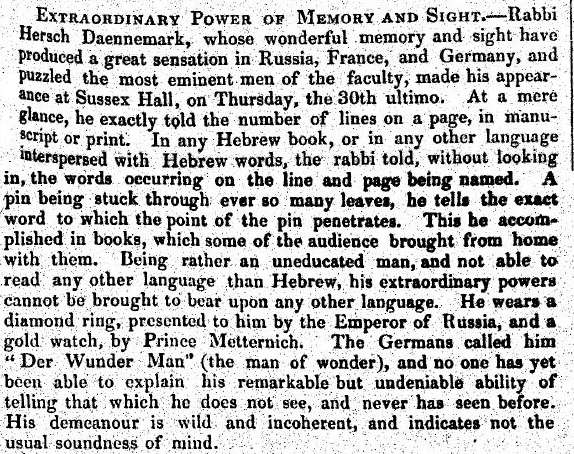
so I decided to dig a little deeper. A much fuller account was printed September 9, 1846 in the Manchester Guardian. As you can see, the exhibition seems to have been billed as a supernatural demonstrator. The reporter found that it did seem to exhibit his extraordinary memory, but no supernatural powers:

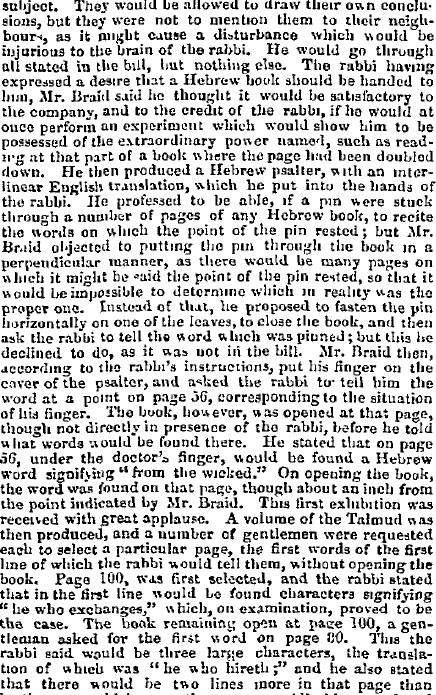

The January 7, 1875 issue of The Academy referred back to Rabbi Hirsch Denmark in an review of a book about memory:


This article notes that Prosper Lucas wrote about Hirsch Denmark, and indeed he did. Several pages of his 1847 book Traité philosophique et physiologique de l'hérédité naturelle are about Hirsch Denmark (413-419):

To summarize Lucas's account as best as Google Translator was able to provide: Hirsch Denmark is a great example [of Lucas's thesis about heredity), because of the public nature of his cases, and the empirical reality of his phenomenon. He arrived in Metz in August of 1842 bearing letters from the Pope, Prince Metternich and famous professors in Germany. He is a Polish Jew, average looking, and aged 34, and he appears very nervous. He said that he first became aware of his strange power at age 12. He considers it a gift from God, sort of a combination of the natural and the supernatural. On the one hand, he acknowledged having a phenomenal memory. On the other, he claimed to be able to do it with works which were unfamiliar to him. He refers to himself as "Der Wundermann."
He gave three demonstrations in Metz. The first one was on August 2, and was attended by the Chief Rabbi and some Hebrew scholars, the second at the Seminary where the teachers all knew German and Hebrew, and the third in a private home, attended by several notables. Next follows a description of the Talmud, and notes that it consists of 36 volumes (bibliophiles are welcome to recognize the particular edition). The following were how the demonstrations were conducted:
1. He has people look at the book and affirm that there was nothing suspicious about the book that could indicate that there was a trick.
2. Hirsch asked someone to to place a finger or pin inside a closed book, which is then turned on its side. He then said which word the finger was covering, or if it was covering white space.
3. He asked several people give a page number and designate a few lines from the top or bottom of the page, either text and commentary. In one case he was asked to read a certain line on page 38, and it wasn't what he had said. Then he told them that there was a misprint in the page number, and it should be on the following page, and indeed it was.
4. He'd have someone put his ear on a page, and he could tell which words were covered by the ear. Then he could do the same with several pages closed together.
5. More of the same.
6. "
7. They opened a book at random, and stuck a pin in. He was asked to tell which words were at that place in pp 58-71 of the volume. He would also indicate where it crossed no word. Sometimes he would recite the word, and then also add what the commentaries on the page said about the word.
When he quoted a verse (ie, if the place landed on a biblical verse) he'd repeat the entire verse.
8. A Hebrew translation of the New Testament was brought to him. After reading it he was able to perform the finger experiment as well.
9. Gerson Levy (1784-1864) produced a Hebrew manuscript written in the Hebrew cursive used by Polish Jew, but it also contained square Hebrew used in printing. If someone's finger was on the cursive, he indicated that they should put it elsewhere, where the other kind of script was and he was able to perform. He also was able to do it on other books provided by Levy that he was unfamiliar with.
One thing to note is that before performing, he would always touch the volume and some of its pages. Asked if it would suffice if he could touch a person in contact with the book, he said that he didn't know, never having tried it.
When a book was placed on top of the Bible, he hesitated for some time, and then began to read the designated line. He was then asked to do it without touching the Bible, but refused. Finally he agreed to do it touching the hand of someone touching the Bible with his handkerchief.
At this point the author footnotes that in his opinion his insistance on touching the Bible was because of his belief in the supernatural aspect to his ability. He was able to do this, although sometimes he made small errors, such as coming to the line above or below the one he meant,
Lucas says he will omit the accounts of how he triumphed before the Pope in Rome, although he does mention that Hirsch was given a Hebrew manuscript in gold letters from the Vatican library, and succeeded.
Any noise in the room caused Hirsch Denmark to act like he was in pain. He insisited on only performing indoors, and required total silence.
Lucas concludes the account by noting that Denmark told him that he has a ten year old son in St. Petersburg with similar, or even more remarkable abilities, and this was demonstrated before the Czar of Russia.
At least, that is a sense of what it was about.
I looked a little deeper and saw that there was an account of him as early as 1839. The following was printed in The Family Magazine (published in Cincinnati, but this does not mean that Denmark had visited America. The demonstration was at a popular venue in London):
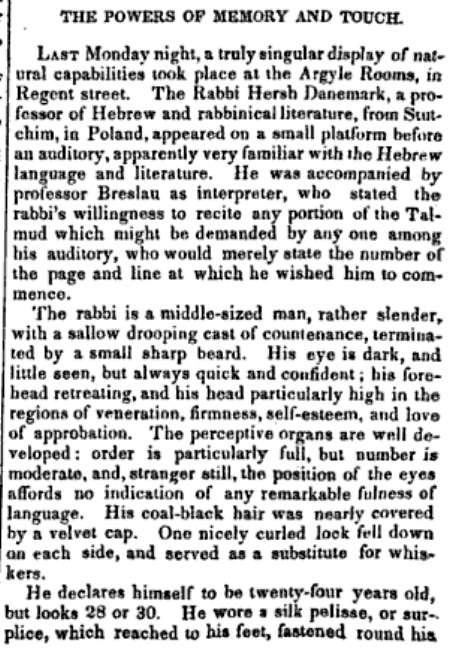



This is all that I've been able to learn thus far. I will add a new post if I learn more.
Finally, below is a famous article "Mnemonic Feat of the Shass Pollak" by George Stratton in the third issue of the 1917 Psychological Review (24):
Sunday, January 24, 2010
Thursday, January 21, 2010
I review Resurrecting Hebrew by Ilan Stavans.
Many readers might find the intensely personal element in this book interesting (e.g., Stavans recounts in detail his upbringing in Mexico, education at a Yiddishist schul, time spent in Israel, his picking up and dropping Hebrew, etc.). Not my cup of tea, but I suppose it is valid for his book about his interest in Hebrew. I do, however, find his choice to allow a bizarre dream he had of a naked woman speaking an unknown language that he thought might be Hebrew, to be a recurring element in the book to be terribly self-indulgent.
In any event, at the end of the book there is a (partial) bibliography and one can see that he read quite a bit of relevant material, so some of the errors I am about to call attention to suggests that the author was not fully up to the task of writing this book, despite his meeting with some true experts in the subjects discussed therein.
For example, Stavans met with Angel Saenz-Badillos who is an expert on the Hebrew language in all its stages. Indeed, he wrote one of, if not the best descriptions of the Hebrew language available (here). The man knows Hebrew.
On pg. 17 we read the following: "Saenz-Badillos was a patient guide as he walked me through the uniqueness of Hebrew in the community of tongues. . . Among the earliest archaeological items available, the Gezer calendar, dicovered by R. A. S. Macalister in 1908 and preserved in Istanbul's Museum of Antiquities, dates from the tenth century B.C.E., the time of King David and King Solomon. Its six lines are a record of the labor connected to the construction of a tunnel at the time of King Hezekiah, mentioned in 2 Kings 20:20 and 2 Chronicles 32:3 and 33:14." Here Stavans conflates the Gezer Calendar with the Siloam Inscription. I am sure Saenz-Badillos told him about both, but a quick check of his notes with Wikipedia would have prevented this error. By the way, his editor does not get off the hook either, for his errors are also the editor's errors.
Turn a couple of pages (pg. 22) and Saenz-Badillos allegedly tells him that the Masoretes "produced guidelines for pronunciation and grammar through diacritical marks called tag (plural, taggin), marking the way letters and words ought to be accented. The taggin aren't letters per se. They acquire different forms, sometimes appearing as little strokes at the side, below or above a letter. There can be letters with one stroke, two, three, and even six. The signs include the dagesh, mappiq, raphe, and the diacritical points on the shin. The taggin enable today's listeners to know how Hebrew was pronounced. They make the reading of the text harmonious, enchanting, hypnotic even." Unless Saenz-Badillos holds some strange outsider theory that all the nekkudot and te'amim are properly called taggin (as opposed to what everyone else calls taggin themselves) what must have happened was that Stavans misunderstood him. Possibly he misheard "te'amim"?
On pg. 112 Max Weinreich's chestnut that the difference between a language and a dialect is posession of an army and a navy is quoted. Stavans then states that Israel's Akademiyah la-Lashon ha-Ivrit is that army and navy. I'm pretty sure that the IDF is Hebrew's army and navy, so I think he may have misunderstood Weinreich's partially tongue-in-cheek comment, the meaning of which is really a razor sharp observation on language and politics.
On pg. 130 he tells of an encounter with novelist David Grossman. The subject of American Christian Zionism came up, and Stavans told Grossman about Hebraism among early American Christians, something which he obviously picked up by reading a single book: Shalom Goldman's God's Sacred Tongue; Hebrew and the American Imagination. It's obvious that he read this book (which isn't a bad book) because he goes on to write that 'I told Grossman that the list of Hebraists in America was astonishing. "George Bush, an ancestor of presidents George H. W. and George W. Bush, was one. So were the explorer and consul Selah Merrill, the educational reformer William Rainey Harper, the theologian and pastor Reinhold Niebhur . . . " (What about Ezra Stiles?) This list, including odd choices like the little known Selah Merrill and the better known for his theological, rather than Hebrew, expertise Niebhur comes from Goldman's book. Which is fine, but nowhere is this book mentioned in the bibliography even though his entire conversation came straight from it. I doubt Stavans meant to hide this source; after all, he lists many, many books and doesn't pretend to knowledge he didn't have. I just think it sloppy not to have included it.
On page 174 he refers to "David Samuel Luzzatto," which is more his editor's fault than his. However it's clear that some of his supposedly knowledgeable informants are either neophytes, or merely treating him like one. For example, the person who mentions Luzzatto to him shows him a copy of his Prologomeni (which must be Aaron Rubin's translation since it gives the English title. Which is weird, since Aaron Rubin provides a blurb for the book on the back cover, but no mention of him in relation to the book!). She informs Stavans that "Luzzatto argues that the Spanish period known as La Convivencia . . . was fertile in linguistic explorations." I honestly have no idea what Luzzatto has to do with this, or that it required his book to make the point. This is an irksome example of something that has no name, but which I describe as follows: ascribing something elementary to some authority just because. I guess it makes the fact seem more erudite? He describes Shadal as one who "studied Talmud as a child. But he was interested in languages." This is technically correct, but he also studied languages as a child. If this is supposed to portray him as some envelope-pushing pattern-bender akin to some kid in Galicia secretly reading Ben Ze'ev's Talmud Leshon Ivri, it doesn't work. In trying to portray the genesis and evolution of modern lingustic study of Hebrew his informant also claims that the Wissenschaft chevra "pushed Hebrew grammar out of Talmudic discussion and into academia." This is wrong in about 5 different ways.
Did I mention his naked woman dream and how he mentions it to everyone he meets, most of whom essentially politely don't laugh? Or that he bookends the dream with a real encounter with a woman who walks in on him in a sauna, not realizing anyone was in there? She was naked!
There are some typos ("Klauser," pg. 110). Not a huge deal, but it is irritating. In short, great topic, wrong book.
How should we pronounce "ibn" as in "ibn Ezra"?

Before I outline the problem, let's lay out some assumptions and facts.
First, there is no doubt that the Hebrew אבן, sometimes written as ן'י, used as part of the name of many Spanish Jews and their descendants is the Arabic word ابن, son of. The usage is equivalent to the Hebrew בן, although it need not always refer to the person's father. It often refers to a grandfather or other ancestor, which is also an accepted, expanded use of בן. Furthermore, in Arabic the word is pronounced ibn, subject to an important qualification. The qualification is that it appears that the Spanish Arabs did not pronounce it ibn, but rather pronounced it aben (please note, incidentally, that the vowel shift here is the same as that between two of the possible pronunciation of the word רבי). The following entry is from E.J. Brill's first encyclopaedia of Islam, 1913-1936, Volume 1:

Thus, it would seem likely that Ibn Ezra (and all, or most other Sephardim) pronounced it aben and not ibn, as the current common practice is. My assumption is that the way which Ibn Ezra himself pronounced it should carry some weight, even if it differs from how we pronounce it.
Below is the entry אבן in Elijah Levita's Tishby (Blogger doesn't do nekkudot well):
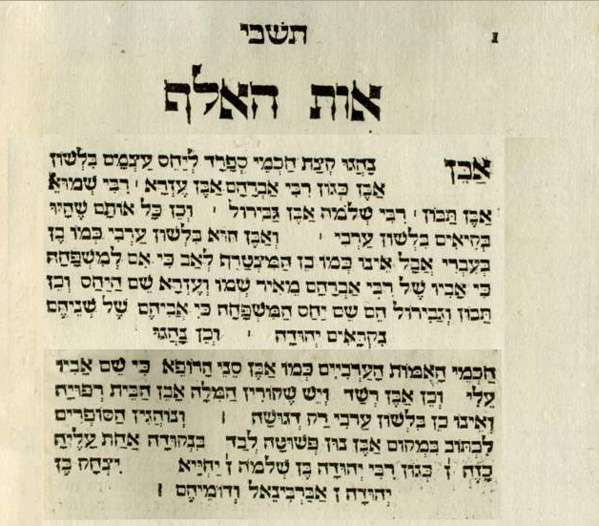
That was from the 1541 Isny edition. Please note that the image is a composite. אבן is actually the second entry, and extends to two separate pages, with Latin translation in the middle. I'll admit that I am unsure why the entry is vocalized with a tsere, while all instances receive a segol in the entry itself. This does not seem to be a mistake, since the book includes a list of corrections by the author at the end and this is not mentioned. In addition, it should be noted that the author was a grammarian whose method is to vocalize according to grammatical principles rather than usage. This can be seen all over his works, where words are vocalized in ways in which we are not used to (mainly because he did not succeed in pressing those vocalizations into common use). In addition, he often criticizes conventional vocalizations for being grammatically impossible. For example, he roundly rejects the vocalization of רבי with a sheva under the resh and a dagesh in the beis as impossible. This vocalization was common in manuscripts, see below. He assigns, rather, a chirik under the resh as correct. His observation was seconded by Rabbi Jacob Emden two centuries later, however his solution was to retain the sheva, but change the beis to give up it's dagesh.
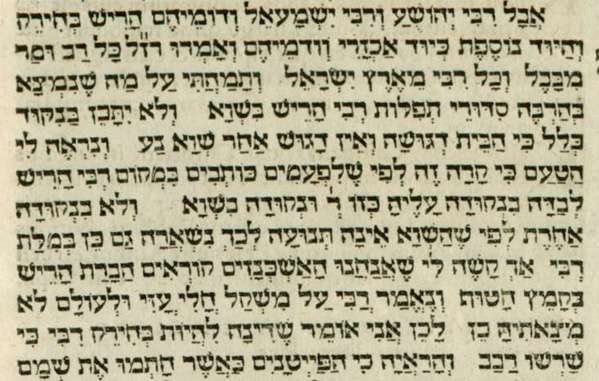
Below is a beautiful late 13th century manuscript (from the Kauffmann collection, ms 388a) which vocalizes רבי in exactly the way that Levita and Emden realized were (grammatically) impossible:
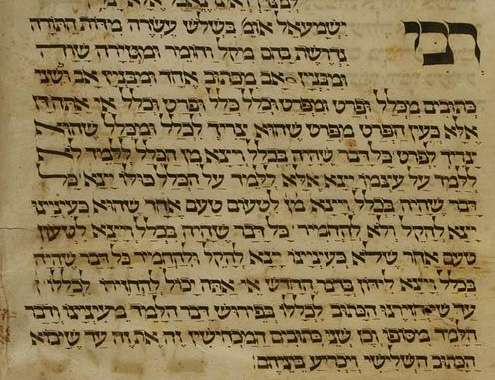
Here is how Rabbi Emden discusses the vocalization:
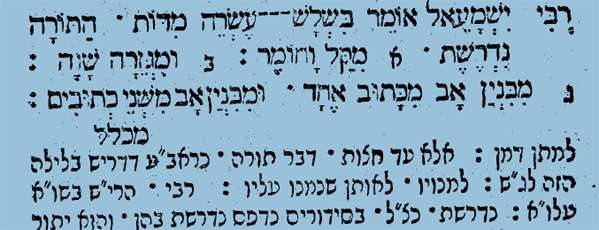
While I'll admit that for some reason it looks like the ב has a dagesh (and I can't explain it, unless it's a typographical error or the result of a bad scan), elsewhere Emden reveals more:
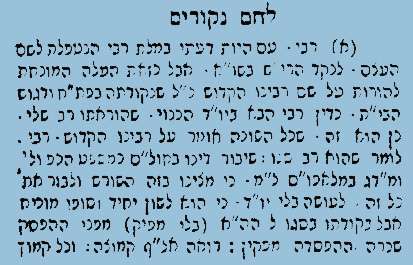
This is from his comment on the first Mishna of the second chapter of Avos. As you can see, he reiterates his contention that the resh receives a sheva, however he also comments on the proper vocalization of רבי as the title for Rabbi Yehuda Ha-nassi. In his opinion this word is different from conventional occurrences of the word, for it does not mean "rabbi" the same as the conventional title, but is more personal, meaning "My master [rabbi]." Thus, rather than point it with a sheva it receives a patach (ra-). More importantly, he spells out that the ב has a dagesh. I believe I am not incorrect in inferring that according to him in the conventional occurrence the ב does not have a dagesh. This would be the same grammatical error that R. Elijah Levita corrected. Indeed, in later printings of Rabbi Emden's siddur the ב has no dagesh, and there is a parenthetical insertion affirming this after R. Emden's original comment. Whether this is proper without clearly stipulating that it's an addition by a later editor is a perfectly fair question.
But we hardly need to make pilpulim like the one I just made. On page יט of his Luach Eresh (letter נ) he says it explicitly:

And here is how his predecessor Rabbi Solomon Hanau points it in his Siddur Beis Tefillah, a truly wild solution, although arguably not any more wild than what is, essentially, "Rivi", being that both are unprecedented:
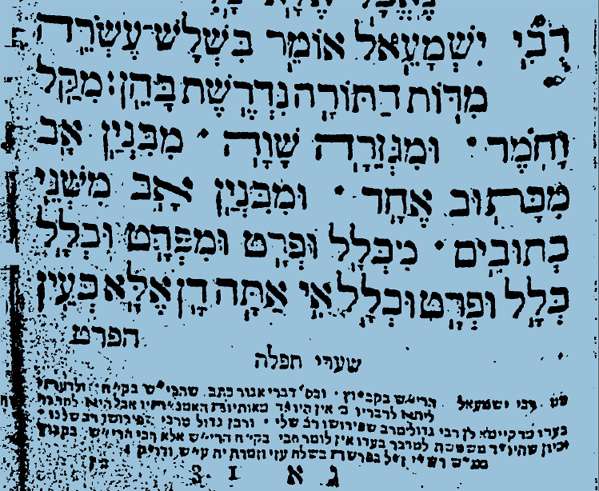
To add another wrinkle, below is a comment in Johann Reuchlin's De Arte Cabbalistica (1517):
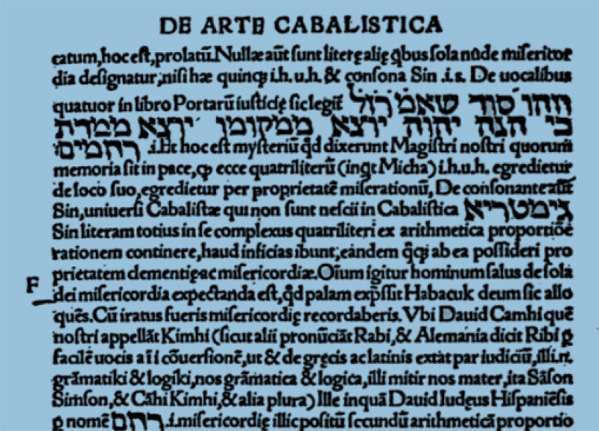
" . . . On this, David Kamchi -- Or Kimchi, in our pronunciation (like the way some say rabbi, and the Germans say ribbi because it's easier; and like the divergence of opinion of Greek and Latin on grammatiki and grammatica, and logiki and logica, mitir and mater, and so too Samson and Simson, Kamchi and Kimchi, and so on) -- anyway, this Jew, David, a Spaniard, teaches . . . "
Amazingly, he writes that the Germans say ribi. This seemingly contradicts the testimony of R. Elijah Levita, who lived at the same time. However, it's possible that i was Reuchlin's closest equivalent of how the Germans pronounced chataph qomatz, which is itself interesting. Of course one would like to know how Germans pronounced the Latin i in the early 16th century!
Since this post is ostensibly about ibn and not rabbi, getting back to Levita's entry for אבן we can also see his tendency to vocalize according to grammatical rules from the way he vocalized Tibbon and Gabirol. In both cases he conformed with Hebrew grammar and omitted the dagesh, although in Arabic (and these names are Arabic) they would receive a dagesh. I can't say much about his decision to vocalize what we call Tibbon as Ta[bb]on, because I am not certain if he did it for Hebrew grammatical or another reason. I will say that Tabbon seem to conform to the shift we see in Aben, which seems to be the Spanish Arabic pronunciation. My purpose in noting that his vocalizations would seem to be motivated more by grammatical correctness than by usage is to demonstrate that there needs to be some suspicion, or at least caution, on his value as a witness.
However, he is far from the only witness to the pronunciation of the Arabic ابن written in Hebrew as אבן as Aben. Essentially it is always written so in European languages until well into the 19th century.
Below are some samples:
Sebastian Muenster, 1527:
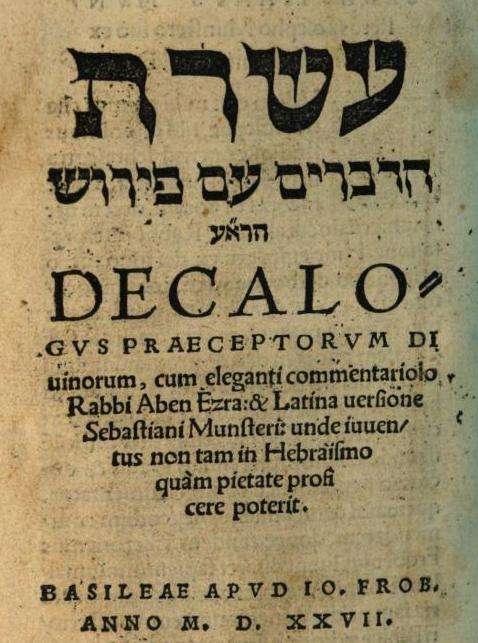
Buxtorf, 1613:

A very typical example from 1723:

In fact as near as I can tell "Ibn Ezra" simply does not make an appearance until the 1820s. It is surely possible that there are some stray examples before then -- I have found a couple of "abn"s:

But apart for that possibility, it seems certain that the 1820s was when "aben" began to give way to "ibn." Why "ibn" was never used before the 1820s, and became about equally used as "aben" in the rest of the 19th century, and to be almost totally preferred in the 20th is an interesting question. Tentatively one assumes it has to do with increased exposure to modern Arabs in the Levant. In fact, here is how it is written in the German edition of Jehoseph Schwarz's Das heilige Land (1832):

This in addition to many other citations of Arab names with "ibn." Old habits die hard, and look how Isaac Leeser writes it in two separate places in his 1850 translation of Schwarz, "The Holy Land":


What is clear is that "ibn" was on the ascent as being scientifically more correct, and "aben" on the way down. As the century progressed almost every mention of medieval Arab philosophers with "Ave-" names includes a note that it is a "corruption" for "Ibn" Whatever.
Although it isn't necessarily clear what conclusion to draw from the following, late samples, it seems possible that some Jews understood אבן, at least with respect to Ibn Ezra, as an abbreviation for אברהם בן. It would seem me then that they must have pronounced it Aben, and not Eben (or Even), and certainly not Ibn.
For example, in a work printed in1853 we find א"בן:

Here's אב"ן in a Yiddish work from 1894:

and there are many more such examples.
In any case, writing in 1896, here is Steinschneider:
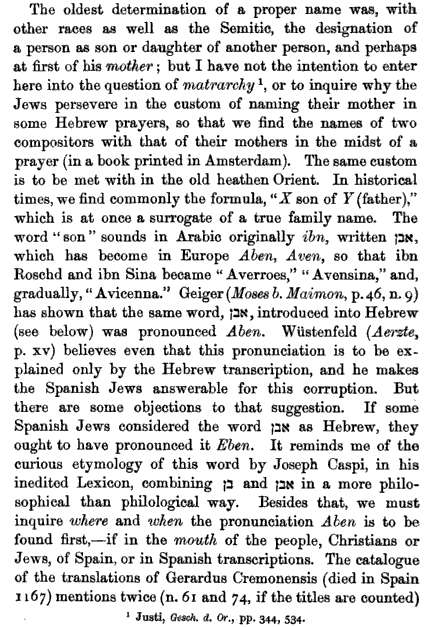
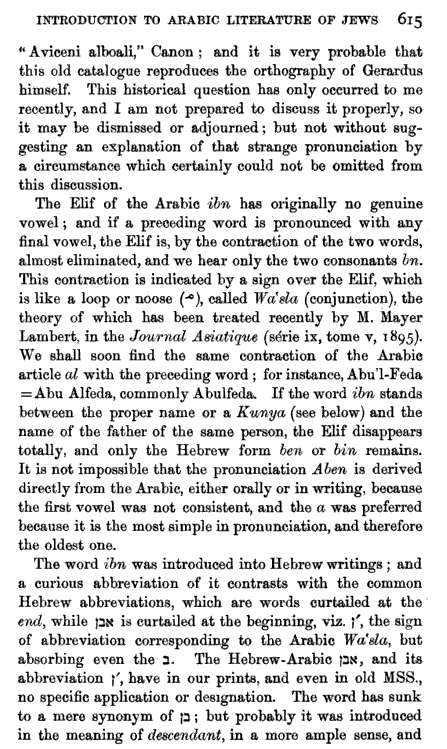

As we can see, he is less certain that the author of the Encylopedia entry who asserts that it is how Spanish Arabs pronounced it. Still, this brings us back to Levita, who was close in time and place to Spanish Jews, and presumably he knew how they pronounced it. However it should be noted that he doesn't explicitly make this claim. Rather, the example he gives is the pronunciation of the names of Arab scholars, like Avicenna. However, we know this is how European scholars pronounced it. Do we (and he) know that this was how the Arabs, in Spain at least, pronounced it? Nevertheless, he must be given weight since, as I said, he was familiar with Spanish Jews. In fact, he was already an adult by the time of the expulsion of 1492.
Finally, writing in 1873 Michael Friedlander gives this note:
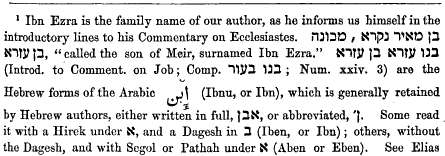
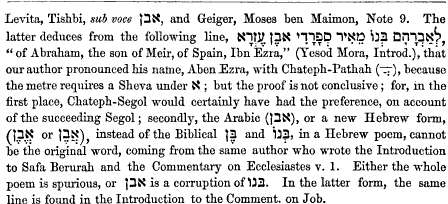
In conclusion, the upshot seems to be that "ibn" is an anachronism. Not necessarily wrong in the same sense that calling the subject of our post "Abraham" is wrong; that's merely a translation of his name into English. In all likelihood Aben or something close was how Spanish Jews with אבן or ן'י as part of their full name pronounced it. Thus "Aben Ezra" is fully justified.
Wednesday, January 20, 2010
Haham David Nieto's letter to Christian Theophile Unger
It's long, but includes some interesting details, such as that Nieto off-handedly refers to Rashi letters as משקיט (see here), and also he asks Unger to write him back in Latin, because he can't read the Ashkenazic Hebrew script! Also interesting is that he notes that he had not been aware that the book חזוק אמונה was written by a Karaite. Strangely, rather than get angry and retort !שקר וכזב to Unger, he accepts this interesting fact. Hm.


“Greatest of Sages, Chief among Preachers, Ornament of Saints, My Master, Distinguished One and Friend, the Great Sage who is adorned with all manner of wisdom and prudence, the exalted, honoured, and distinguished Christian Theophilus Unger, Peace, from one who proffers peace.More Hebrew correspondence between Christian Theophile Unger and Jewish scholars can be read here, published by Shadal in the 3rd volume of Ignaz Blumenfeld's אוצר נחמד. See also Steinschneider on Unger.
“I have received a letter some days ago from your exalted distinguished honour, and it revived my spirit when I saw that cognizance had been taken of me, and that I had found grace in the sight of a man possessing wisdom and a man of accomplished understanding, and behold I am ready to answer the questions in his gracious epistle in the order he has put them as is his desire; and also to serve him, and to minister unto him according to all the Master may command.
“At first I will say I have neither seen nor heard of a work by Jacob son of Amram in any language, nor of the book Gate of Truth. The Haham Rabbi Menasseh ben Israel died and was buried in Amsterdam, and an old man told me that he expired in the year 1655 or 1656 according to your calculation, but I do not know anything about his books in manuscript. R. Isaac Abendana was not a physician, and I do not know the year he died, and in my time I have neither heard of nor seen the book Faith Strengthened in Spanish, neither in manuscript nor printed. Neither he nor his brother had children. The Haham, Rabbi Jacob, mentioned previously, translated the Cuzary into Spanish with a slight commentary, and it is one which I have sent among the books to your exalted distinguished honour; he was Rabbi in this holy congregation many years, and died on Tishri 3, 5456 Anno Mundi. Before him Rabbi Joshua da Silva was Haham; he died on the 17th of yar 5439, and was the author of a book of sermons in Spanish on the thirteen articles of faith. It is a charming book, and I searched for it, and could not find it, and therefore could not send it; but if I find grace in your sight, my Master, and you return me an answer, I will [again] search for it and send it. After the Haham Rabbi Jacob, as mentioned above, the Haham Rabbi Solomon Ayllon of Salónica was received here as Rab; he guided the Congregation eleven years, and from here he went to Amsterdam in the year 5460, and was received as Rab, and he is still there. After him, I received a call from London from the City of my habitation, Leghorn, where I was Dayan and Preacher of the Congregation and Physician, and came here at the end of Elul 5461; and the city of my birth is Venice. And here I have printed four books, one in Italian, Pascallogia [sic], which I composed in Leghorn in the year 5453, that is 1693, and published here in the year 1702. Although Colonia is printed on the title-page, it is not correct, as I was forced to state so from fear that the Christians in Italy would not receive it: Ratione Autlioris et Urbis ab eis Hereticam appellatam. Afterward I printed a book in Spanish, entitled Divine Providence, in the year 5464. In the year 5474 I printed the book Matteh Dan in the holy tongue, and translated it into Spanish; and sought for a skilled mechanic to cast type of the holy tongue, and also משקיט or Rashi type, and now they are in my possession. I also printed a calendar in Spanish, from the year 5470 until the year 5550 inclusive, but my name is not inscribed on it because at that time I was very much troubled with communal matters, and there were a few errors in it, and I had no opportunity to correct them. If Providence grants me life, it is possible that in the coming winter I will print another calendar up to the year 5511,and there I will correct the errors. Some time ago I heard that the author of the book Faith Strengthened was a Karaite. What your highness wrote about this was quite new to me, and I was as pleased as one who finds a great treasure, and in order that I should not forget it I have put the note at the beginning of his book. I also would inform your exalted and distinguished honour that the Haham Rabbi Jacob Fidanque, his memory be for a blessing, died in the month of Heshvan 5462. I was here during his illness and visited him, and buried him and delivered a funeral oration. His son died on the 4th day of Elul 5469, and he only composed the books known to you. Rabbi David Pardo died in Surinam in America, nearly three years ago, and he only composed what your honour knows. The Haham Rabbi Phoebus is living and well: long may he live. There is no tombstone on the grave of Isaac Abendana, and I know nothing about our teacher, Rabbi David Mungon, nor his book. I have sent a letter to the Haham, Rabbi Moses Hagiz, to Embden, the place where he has resided the past year, but I have not yet received his reply, as he is ill in consequence of the climate of the country not agreeing with him; when it arrives I will forward it immediately.
I would request my master to write to me in Latin, in plain Roman letters, as I am unable to read the Ashkenazi Hebrew script; for this I most humbly apologise to my master, and I will also reply in the Latin tongue to your exalted distinguished honour.
“Yesterday I handed the Secretary of the Envoy of the King of Poland (May his Glory be exalted), these books—
The Cuzari in Spanish.
Matten Dan Vecuzari Chelek Sheni.
De La Divina Providencia.
In this book I have not inscribed my name
openly on account of the squabbles of a minority of the Yehidim of the Holy Congregation with me; but if your Highness will look at the letters that the typesetters use to index the printed matter he will find under A vel B, from leaf 1 up to leaf 53, Sr H.H.R. David Netto [sic] Rab del K.K. de Londres.
“I am also sending as a gift an almanac I have written, as described above. I will implore of God the Creator of Heaven and Earth to prolong his days in goodness and his years in pleasantness, such is the soul’s [desire] of his servant and attendant seeking his peace and welfare here in London. Tamuz 27, 5479.
A final thought: it's a great deal of fun to see how scholars got on in time's past. Today, when you're researching a topic and want to reach out beyond your immediate circle you can email your queries, or you can reach out on Listservs and message boards being as private and as public as you want. In 1915 Israel Solomons sent an observation and a questions that were clearly part of the preparation of the paper from which the above translation is drawn to the periodical Notes & Queries. Here they are:


Tuesday, January 19, 2010
Some notes on a famous penitent apostate, Ezekiel Stanislau Hoga.
[Hoga] had been a Government Censor of the Hebrew press in Russia. On coming to London, he came under the influence of the Rev. Alexander McCaul (Father-in-law of James Finn, the British Consul at Jerusalem), who induced him to become an apostate. They co-operated in the production of " The Old Paths "... London : . . . 1836-1837, which Hoga translated into Hebrew. He died repentant about the end of the year 1849. The Hebrew translation he had made of " The Old Paths," entitled נתיבות עולם was not published until 1851. ("The evil that men do lives after them ; . . .")Actually Hoga had converted in 1824 or 25, well before moving to London, and thus before he met McCaul. In addition, the Hebrew edition of Old Paths was first published in 1839 (see). Presumably Sokolow was misled by seeing a later edition. For example, here is a Hebrew edition published in 1870. Similarly, Beth-Zion Lask Abrahams's detailed article "Stanislaus Hoga—Apostate and Penitent" (lecture in 1943) in the 1945 issue of the JHSE mistakenly gives 1845 as the year of its publication.
In the July 1839 issue of the Missionary Intelligence column of The Orthodox Presbyterian theological review and missionary recorder one sees the following:
In any case, it should be noted that it was not I who caught the mistaken publication date, but Dr. Sid Leiman nearly 25 years ago. See his The Baal Teshuvah and the Emden-Eibeschuetz Controversy, Judaic Studies 1 (1985), pp. 3-26, where the entire story is approached through the lens of how Hoga appears in modern rabbinic legend.
In a book written against the Old Paths, published in 1864, we see the following:


The interested reader is directed here to continue.
Hoga's name appeared on a most interesting list. In 1840 the Damascus Affair, a then-shocking modern revival of the long forgotten Blood Libel, flared up. The aforementioned Alexander McCaul, author of "Old Paths" wrote a book called Reasons for believing that the charge lately revived against the Jewish People is a Baseless Falsehood (dedicated by permission to Queen Victoria), London, 1840.
This brief work sketches six reasons why the charge must be rejected as false. They are as follows:
1. The charge is made only in times and places of ignorance, and in places lacking justice, or where confessions elicited by torture are accepted as testimony. As he asks, "Why is it that no case of this kind now occurs in France, or Holland, or Prussia, or England?" He continues, that [anti-Christian] bigotry is still strong among "a mass of the Jewish people," and "the prejudices of the unedicated multitude against the Jews are, generally speaking, as strong," and yet it does not occur.
2. The charge is confined to certain places in the world. If the requirement of Christian blood was really a part of Judaism, then the charge should have spread as far as Judaism itself. However, notes M'Caul, as far as he knows the charge has never been made in Asia or Africa until now.
3. The charge is comparatively new, only since the 13th century. Although Apion brought a similar charge against Jews in ancient times, and this may indeed have served as the model, for many, many centuries of the Christian age the charge was never brought. Why would the Jews crucify Christians in later ages, and right under the noses of Christian governments, while in earlier times they were under the government of heathen emperors, and presumably such a crime would have seemed less heinous to them?
4. The Blood Libel is part of a pack of medieval charges lodged against Jews, and all the others are now seen as ridiculous, such as piercing the host, poisoning the wells, and causing the madness of Charles VI of France and numerous others.
5. The reason given for why Jews need blood is one of many ridiculous ones. For example, not only was it alleged that the need was to bake unleavened bread for Passover, but "it used to also be gravely asserted that they used Christian blood to free them from an ill odour, which it was supposed, was common to the Jewish nation." Other popular reasons were that the blood was used in love potions, or to stop the bleeding of circumcision, and many more.
6. Finally, there is a total absence of credible testimony. The only evidence in the Damascus case was extracted through torture, and that method could cause anyone to confess to anything, including being personally responsible for an earthquake!
He could not be more clear:
McCaul then produced a letter signed by "competent witnesses" which he collected. It includes a list of names of Jewish apostates, described in the following mannner:
"Here are persons, neither afraid nor ashamed to give their names and the place of their birth, some of whom command respect by the offices which they now fill, many of whom have been rabbies, readers in synagogues, Jewish schoolmasters, candidates for the rabbinate,—all of whom are ready, if it were necessary, to give evidence on oath,— men born in Judaism, and educated in various parts of the world, who all declare their ignorance of the crime here imputed to the Jewish people,— witnesses who gain nothing by giving this testimony, and would lose nothing by testifying the contrary, if their conscience allowed them. Amongst them are those who have conducted all the religious ceremonies to which the monk refers, who have ministered at circumcision— watched over the preparation of the Passover cakes,—and performed the last sad offices for the dead. Some of them once members of that most fanatical of Jewish sects, the Chasidim, to some of whom, if any use of Christian blood existed, it must have become known, but who have thankfully and zealously embraced the opportunity now afforded them of protesting against the falsehood of the accusation. They all answer as, with the one exception already stated, all converts have done for the nineteen years that I have had an opportunity of being intimately acquainted with the Jewish people. They have earnestly and solemnly denied the charge.
Such testimony far outweighs the evidence produced on the other side. "
As you can see, Hoga is on this list, described as "son of the Rabbi of Casimir."
An appendix is included which adds signatures of "believing Jews," which from my perspective probably should read "disbelieving Jews":
This list was brought in a different form by Moses Margoliouth in 1847 in his periodical The Star of Jacob. Compare:
Getting back to Hoga, among his other literary productions was a book printed in 1840 called שפת בריטאניא, subtitled also titled "A grammar of the English language, for the use of Hebrews." The book is notable for being written in Hebrew, rather than Yiddish, which means that his intended audience was fairly scholarly. It is also written in Rashi letters (with the occasional Vayberteitsch note, for example:
 )
)It includes such interesting examples as these:




